
A Pontic camel cavalry unit crossing the Asiri desert steppes.
Colonization and Exploration[]
Since antiquity, Asir was known as the Caucasia Territory, a distant and remote protectorate of the Calzadorian Empire. After the Second Great War, the Empire withdrew its token military force from the region to consolidate its diminished territories farther into the interior of its own nation. The Bedouins rose up as they departed, forcing a humiliating military defeat upon the retreating Calzadorians. In the year 2973, the Pontic Empire was admitted into the UKO Organization. With this, Emperor Attalus I was allowed to lay claim to a frontier territory. The southwestern region of the Mainland known as the Caucasia Territory was formally recognized by all fellow UKO members as a part of the Pontic Empire on January 1, 2974. The Emperor formally decreed it as the Imperial Province of Asir and opened it to military exploration and civilian settlement. The Imperial Administrator, Markos Samaras, arrived on January 10th of the same year, leading 10,000 armed cavalrymen using camels for tranportation. The city of Karachi was founded where the army landed ashore, on the small Spur Peninsula. From there, the army proceeded inward to the interior of the province. Sporadic clashes with native Bedouin tribes occurred throughout the country as pacification efforts pressed on. The provincial capital of Karachi was founded on the Spur Peninsula in 2974 and has quickly grown into a major trade hub, linking the known world to the east with the unknown realms to the west.
Geography[]
Asir is the westernmost region of the Mainland. It is bordered by the Great Ocean to the south, the Ardglass Colony to the east, the Lockenhess Sea to the north, the Kingdom of Aryana to the northeast, and an uncharted peninsula of Centura Donna in the west that forms the Straits of Lockenhess with the westernmost tip of Asir. The Pontic Mountains are located in the center of the province, with Asir's highest point located within it, Mount Aztlan. The capital city of Karachi is located on a cliff at the tip of the Spur Peninsula, which juts out into the straits and overlooks the uncharted peninsula of Centura Donna just on the other shore to the northwest. The province is divided into five regions: the Northern Desert, the Southern Desert, the Pontic Mountains in the center, the region around Karachi, and the Angara River Valley. The Angara River Valley runs the length of the province from the east out of the mountains down to the outskirts of Karachi in the west, and dividing the deserts. It runs parallel to the Trans-Asiri Railroad, and provides the province's food supply. The Northern Desert and Southern Deserts are lightly populated by mostly wahabbi Bedouin tribes, and are mined extensively by the Pontic Enterprise, the Empire's only state-controlled corporation. After the colonial war of 3002-3 with Persia, the former Kingdom of West Bavaria was largely absorbed into the province of Asir. Asir's new eastern region is littered with small mountain ranges and is largely rural, mountainous, and untouched by mankind like the rest of Asir.
Climate and Environment[]
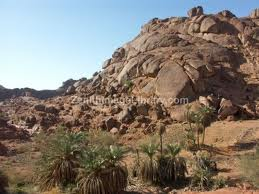
The harsh desert climate of Asir. It only hosts limited fauna and flora which must be extremely hardy to survive in the Asiri climate.
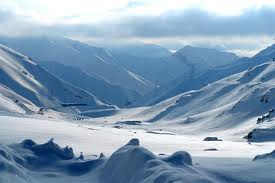
The Persian lands of eastern Asir. This mountainous area is the only part of Asir that is considered cold and also the only part that receives snowfall, due to the extremely high elevations.
Asir is largely arid desert, dotted with several oasis locations that can promote agriculture. The Angara River runs the length of the province from east to west, originating in the foothills of Mount Aztlan and emptying into the the Straits of Lockenhess. The valley around the river provides a renewable source of fertile soil for agriculture, and provides the only main area for sustained, intensive crop farming. There are two seasons during the year. Temperatures rise close to 125 degrees Fahrenheit during the day and fall to 90 degrees by night during the hot season. The temperatures during the cool season generally stay at 70-75 degrees Fahrenheit all day and night.
The eastern third of Asir varies considerably in climate from the two thirds in the west which are mostly an arid desert. These former Persian lands are set in high elevations, which often see large amounts of snowfall in the winter months. This makes that region the only part of Asir that not only receives snowfall, but actually has temperatures at any time of year that could make it possible. There are four seasons in the eastern region, consisting of a short spring, summer, and fall where temperatures stayed roughly around 65-75 degrees Fahrenheit. Winter is long and bitterly cold, lasting almost five months and temperatures average 0-10 degrees Fahrenheit all day and night.
Demograhpics[]
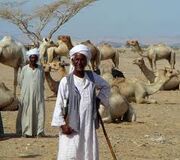
Bedouin natives in the Asiri desert, tending to their herds of camels, goats, and sheep.
The original inhabitants of Asir are the Bedouins ethnic group. There are two subdivisions of Bedouins: the Fellaheen and the Wahabbis. The fellaheen are farmers who raise crops along the Angara River and nearby oases. They farm lands that their ancient ancestors tilled long before them. The wahabbis are more of pastoralists and far less of conventional farmers. They are a nomadic people, tending to their herds of livestock near watering holes. Both of their societies are based on tribal and clan based loyalties. Bedouin society as a whole is very conservative socially and almost all of them are devout followers of Sunni Islam. Collectively, they have violently resisted Pontic intrusion into their lands, but have resorted to raids, kidnappings, and hit-and-run tactics against the local Pontic military bases and units. Recently, the fellaheen have acquiesced to Pontic control, leaving only the most rural tracts of land under rebel control.
The rest of the population is made up of Pontic settlers who arrived to "civilize" Asir, and foreigners who travelled to Asir to seek their fortunes. Asir's population is roughly between 3-4 million inhabitants including the various Bedouin tribes, Pontic settlers, ethnic Persians, and all other foreigners.
The Pontic settlers who emigrated to Asir range from nobles owning large plantations and corporations to common merchants and farmers looking to earn a more modest living in a new world. They have brought their agricultural expertise to the region to create newly fertile lands along the Angara River Valley and also in the few oases redoubts.
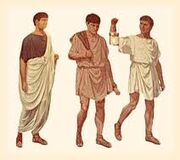
Pontic settlers in Asir.
Foreigners are divided into two classes: Merchants and diplomats are considered free individuals and honorary citizens. They are allowed to carry out their professions without discrimination or fear of alienation from the Pontic populace. Slaves make up the far larger component of the foreign populace. They are property of Pontic nobles who purchased them at slave markets in Asir or brought them along when they emigrated to Asir.
The eastern region is home to a sizable population of ethnic Persians. This ethnic group was the the majority of the former Kingdom of West Bavaria that was administered by the United Kingdom of Persia. Settled high in the mountain ranges, the Persian people are mostly poverty stricken farmers and villagers who were afforded Asiri citizenship in return for their sworn loyalty to the Pontic Empire after the Pontic-Persian colonial war of 3002-3 that saw their homeland conquered by Pontus. Their livelihoods mostly consist of subsistance farming on small, poor quality plots in the rocky landscape. Their homes are mostly huts and dwellings that are carved out of the mountainsides. They are strident followers of Shia Islam, the exact opposite ideologically from their Sunni Bedouin neighbors to the west in the Asiri desert regions. Normally in the Islamic world, this kind of grouping would result in violent clashes but the remoteness of the province and the rugged mountain ranges separating the two groups acts as a natural insulation and barrier between them.
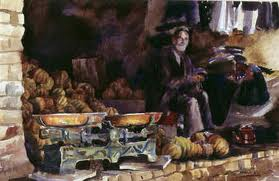
A foreign merchant plying his wares in a bazaar in the Asiri capital of Karachi.

A typical Persian family in their humble mountain dwelling.
Infrastructure[]

Karachi, capital of Asir. The nightline of the city glows for miles in all directions.

A highway in Asir. All roads in Asir are nothing more than flattened dirt highways.

This is part of Asir's solar power grid, which provides almost 90% of the province's energy needs.

The Trans-Asiri Railway is the only railroad in all of Asir. It transverses the length of the province from east to west, following the Angara River. Its enters the province in the east from the Kingdom of West Bavaria and its terminus is the capital of Karachi.
Railroad, Port and Roads
The infrastructure of Asir as of the 2970s was very limited. The provincial capital of Karachi is the only city in the whole province. Its population is estimated at 1.25 million inhabitants. It is a city full of excitement, and a melting pot of various cultures, ethnicities, and religions. It sprawls across the narrow Spur Peninsula. Karachi's exotic mystique has enamored many tourists and travellers since its founding due to its location at the edge of the known world.
The port of Karachi is enormous, and hosts large numbers of vessels each day. However, even with this bustling enterprise, the port cannot handle all of the supplies needed to sustain the city. The port was built as a deepwater type, allowing the largest of oceanfaring vessels to anchor in it. As of 2974, an initiative is underway to double the capacity of the port to accomodate even more sea traffic.
The Trans-Asiri Railway lies astride the whole length of the province from east to west. It is the lifeblood for the majority of the modern Asiri economy, providing many goods from the rest of the civilized world that Karachi's port cannot handle due to cargo limitations. Its solar powered bullet trains provide very cheap and fast travel through Asir on an express track while the coal powered freight locomotives haul cars full of cargo loads on a secondary track. Small settlements have been founded along its path and have benefited from traveller's spending at refilling stations along the whole length of the railroad.
The road system in Asir is not well developed. Outside of Karachi, there are no paved roads, only flat beaten dirt roads that have been used for transportation since antiquity. There is no maintenance on the road system, allowing the provincial government to invest in the rest of Asir's minimal infrastructure. The eastern region's roads and travel routes are always closed and snowbound for nearly half a year due to the winter blizzards. Despite this, the Railway remains open due to constant maintenance by crews stationed at the various refilling stations along the route.
Energy
Asir's energy needs are met with a two pronged plan from the government. All industrial and residential energy needs are met with solar power from a national grid constructed with cutting edge technology. Not only is it efficient and renewable, it allows almost no interference with the province's environment. What makes Asiri solar power more advanced than other conventional solar techniques is that Asir's has been engineered to not require any water to produce electricity whatsoever. All other energy needs are met by conventional means, mostly based on oil and coal, although these amounts of energy are small compared to the needs met with solar power.
Economy[]
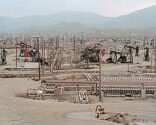
An oil field in Asir.
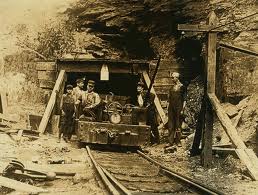
One of the numerous coal mines in the northern desert expanse of Asir.
The economy of Asir is based on three sectors: mining, tourism, and agriculture. Because of the largely rural and still unexplored countryside, only part of Asir's true potential capabilities have been discovered and fully exploited. Agriculture is based on Pontic plantations that have been created as well as the small fellaheen plots of land dotted across the landscape. Mining is proving to provide a bottomless well of currency reserves for the province and the Pontic Empire as a whole. Tourism is a new trend, and while burgeoning, occurs exclusively during the cool seasn in the latter half of the year. Nonetheless, these three pillars are slowly reinforcing a vibrant economy that is developing to this day.
Mining
Asir is very rich in mineral deposits. The province is rich in iron, coal, oil, copper, and natural gas. Oil fields are a common sight now in the Asiri countryside. Recently, coal mines have sprung up after the discovery of immense depoits in the northern desert regions. Natural gas is being extracted from eastern areas of Asir whilst many other mineral deposits have been found and exploited throughout the province. Large iron and copper mines with nearly inexhaustable resources have recently been opened in the eastern Persian region, providing the Asiri administration in Karachi with even more wealth and influence.

Local fellaheen farmers near the Angara River harvesting their poppy fields.
Agriculture
Farming is another important sector of the Asiri economy. Pontic plantations are very large and line the Angara River in the western and central parts of the province. They produce various grain crops including wheat, corn, and millet. Tea and spices are the main cash crops for the whole province. The fellaheen farmers work small plots of land near oases throughout the country's interior for the most part, but also along the Angara River as well. Fellaheen farmers focus mainly on dates, figs, grapes, and various other fruits and vegetables. However, the main cash crop of the local population is the opium poppy. Roughly 65% of all the fellaheen cultivation is devoted to this crop. While this crop is used for food ingredients and medicine, unfortunately much of the poppy harvest is used to create opium and heroin for illegal drug use in many nations of the world. Persian farmers in the east typically raise goats and staple crops that are consumed for foodstuffs throughout the year due to lower quality soil and lack of any plausible irrigation possibilities.
Tourism

Saltwater fishing is extremely popular along the coasts of Asir.

Mountain climbing is one of the main tourist activities in the interior of the province.

Spring Break celebrations on the beaches of Karachi. This week alone draws almost 500,000 tourists to the sandy beaches of Asir's capital.

Gambling is another popular reason that tourists come to Karachi. There's more casinos in this city than in any other across the whole Mainland.
Tourism is new to Asir, but it is also seasonal. The hot season is far too warm to entice many visitors or tourists. The cool season provides roughly half a year's worth of comfortable respite from an unbearable heat wave. With that being said, security is also a lingering concern due to the low level insurgency being waged by various wahabbi Bedouin tribes. Security aside, Asir draws roughly almost 4 million visitors every year, of which almost all visits happening during the cool season in the latter half of the year. Tourism mainly consists of touring the countryside, the vices of Karachi itself, and the capital's beautiful beaches along the Great Ocean and the Lockenhess Sea.
Saltwater fishing, diving, and waterskiing are very popular, but certainly not the only activities on the water. The many coral reefs off the coast provide numerous natural treasures for exploring divers to discover. Any sort of water sports are popular, from skiing to boat racing and everything in between.
Many college students from all acros the various planets of the CentauDos galaxy flock to the white, sugar sand beaches every year for their Spring Break week, providing one last boost to the capital's economy before the hot season that arrives soon after. The week's celebrations turn the whole city and its coastline into one giant, all encompassing party. Friends travelling and rooming together, a perpetual party atmosphere, casual drug use, high alcohol consumption, and sexually suggestive displays fuel the mood of the city for these seven days.
The desert charm of the interior draws many visitors every year. Hiking, bicycling, and mountain climbing are by far the most popular activities in this part of the province. The interior is the only section of the province that has security issues and concerns for tourists. The capital and the popular beach destinations are firmly secure, and have rarely had any security disruptions, especially during the cool season.
The capital of Karachi itself is a magnet for tourists. The city contains many casinos and entertainment centers that draw hundreds of thousands of eager visitors throughout the year, even during the hot season. The Red Light District is renowned for its reputation amongst tourists, and drug dens occupy many buildings throughout Karachi. Many pleasure seekers come to Karachi to seek what is typically forbidden or illegal elsewhere in the Mainland due to Pontic laws being very relaxed on social issues. The current mayor of Karachi, Mehmed Salim, largely summed it up to a group of journalists that he was leading around the city upon its construction:
"You want a city where a person's every desire is at there fingertips? Here it is, gentlemen. The word vice is meant to discourage a person from enjoying themselves. It is a moral term and our religion provides us with a value system that allows us to respect both ourselves and others while still enjoying everything life has to offer. People say that Karachi's laws are too lax on drugs, partying, gambling, and so on. Some say that we allow things that many other countries outlaw. I say to you my friends... anything, and I mean anything, can be good for you in moderation!"
Internal Security[]

Pontic cavalry in the northern desert regions pursuing Bedouin bandits.
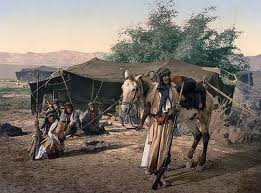
A Bedouin camp in the southern desert. Raiders and bandits move their encampments every few days to evade Pontic long range radar planes.
Asir's internal affairs have been mired in intermittent violence since Pontic explorers first arrived. The Bedouin tribes had never been united in history until foregin occupiers arrived in the province. First, the token Calzadorian forces were harrassed and nearly wiped out before they wisely withdrew at the close of the Second Great War. When Pontic forces entered Asir, they became the target of an intensely violent hit and run campaign by the Wahabbi herders and Fellaheen farmers that populated the province. Because of the vastness of the province's deserts, cavalry was the military's only instrument to use to attack the Bedouins when they would raid and pillage Pontic farming communities. Air power was restricted to long range radar planes that would attempt to locate armed groups of tribesmen for the military to pursue.
After several hard fought engagements with much blood spilled on both sides, the fellaheen largely accepted Pontic rule by 2975. A significant number of Fellaheen laid down their weapons after Emperor Attalus issued a imperial proclamation granting them limited rights. He had planned on enslaving all the Bedouin outright, however, he came to admire their warrior spirit. On December 5, 2974 the Emperor issued his "Proclamation of Bedouin Rights", which exempted the Bedouin tribes from enslavement. However, as a balance to this, a heavy tax was levied on the Fellaheen, which the farmers themselves called a "freedom tax". The Fellaheen accepted the heavy handed peace proposal for the most part, with only a few farming villages refusing the terms. The Wahabbi herders completely refused the terms and remained in the deserts resisting Pontic rule to this day.
When Karachi was first settled, it was the sole source for supplies for the Pontic expeditionary forces in the province. Therefore, the capital's security was given top priority. As the capital grew and thrived, so did the city's garrison. As of 2975, the city's garrison numbered 125,000 men along with armored jeeps, heavy tanks, attack helicopters, and mobile missile interceptors. Many foreign military attaches have toured the city's defenses, and believe that it is impregnable to a standard military attack and infiltration is extremely difficult. Suicide bombings and bomb detonations have occured in the capital, however they have been very rare occasions due to such a heavy military presence.
The interior has had a much more fluid security situation. Due to the size of the province and the limited resources at the military's disposal, complete conquest was deemed impossible. The Trans-Asiri Railroad is looked after daily along its entire length by heavily armed cavalry patrols. The small villages and depots along the route's path have seen occasional raids or banditry. Most of the Wahabbi raids take place along the Angara River where most of the Pontic settlers reside, farming along side the Fellaheen or operating massive plantations with slave laborers. Attacks also take place in areas where mining operations take place, due to the long distances from the mining regions to the populated areas of the province.
Basically, the military's goal isn't to completely defeat and conquer the hostile Bedouin tribes, but to maintain a degree of law and order in Asir. Along with that, the economy requires security, and the military has made a point of making sure that the capital and the railroad remain unmolested by the Wahabbis. The mining regions remain vulnerable, but more cavalry divisions are being dispatched by Pontus itself to help secure those important areas.

Bedouin raiders posing for a photograph after a successful raid on a Pontic mining camp.
Angara River Valley Campaign
On April 25th of 2976, Bedouin fighters razed several farming villages and plantations in the eastern end of the Angara River Valley. After full mobilization, Pontic camel cavalry units were sent to the eastern areas of Asir. A slow, methodical pursuit was commenced with few skirmishes based on the premise of restoring order in the eastern areas. It wasn't until long range radar planes detected a Wahabbi encampment in the foothills of the Pontic Mountains that a full scale battle ensued. The Wahabbi fighters had converged on the small farming redoubt known to locals as Najf.
Battle of Najf
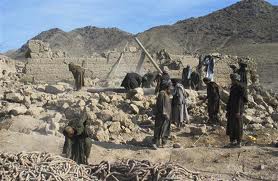
Wahabbi fighters preparing their defenses just before the Battle of Najf commenced.

The result of the saturation bombing campaign during the Battle of Najf. The aftermath was complete destruction and devastation.
The Imperial Administrator Markos Samaras, himself the commanding general of the newly formed Imperial Asiri Field Army (IAFA), planned to deal the Wahabbi insurgency a massive blow. Normally, the Bedouins would only gather in small numbers for raids, but the group encamped in the mountains was nearly 5,000 strong. The Bedouins believed they were safe since there had been a lack of aerial bombardment from the miniscule elements of the Pontic Air Force. General Samaras sent in his camel cavalry through the mountain passes as expected, but before they made contact with the enemy, a saturation bombing campaign was performed to soften up the Wahabbi positions. The result was the complete demoralization of Bedouin fighters, and the cavalry encircled them from all sides taking them by surprise. The Wahabbis, being extreme Islamic fundamentalists, fought to the last man. There were no survivors or prisoners taken from the Battle of Najf, this being a combined result of Wahabbi fanaticism and General Samaras' brutal war policy. In all 4,762 Wahabbi fighters were confirmed dead, along with 796 IAFA soldiers and scores of wounded. This was a crushing victory for the IAFA, but General Samaras was quick to acknowledge that this was certainly not the end of the Asiri Insurgency, nor the end of Wahabbi-inspired violence and suffering. Following this battle, the war reverted back to its original form of guerilla warfare, with the Wahabbis staging raids and suicide or remote control bombings, and also aware of what Pontic airpower could do in open battle against them.
The Insurgency Continues
The years of 2977-80 saw a bloody continuation of the insurgency, albeit on a smaller, but far more active scale. Suicide bombings, assassinations, and ambushes became common in this stage of the conflict. In these years roughly 1,000 IAFA soldiers and Pontic civilians were killed during ongoing operations in the Asiri countryside. By the most accurate estimates, 4,000-6,000 Bedouin fighters and civilians were also killed during this period of wanton violence. One new development during this time was the limited cooperation between Pontic and Bavarian high commands for joint operations in the Pontic Mountains along the border between the two regions that resulted in the capture of several prominent Wahabbi chieftains. During this time, the licensing program to curb illegal cultivation and production of opium started to yield results. By 2980, the percentage of arable land used for opium cultivation had dropped by 15% from the previous year. This caused a small decrease in the insurgency's funding capabilities and reprisal killings amongst Fellaheen farmers who volunteered for the program.
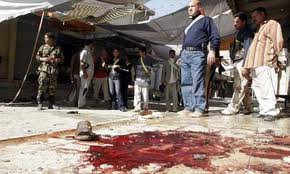
Aftermath of a suicide bombing at a Pontic military outpost in a rural village in eastern Asir.
Aftermath of "La Grande Catastrofe"
On September 1, 2980 a massive terrorist attack was inflicted upon Pontus itself by Wahabbi suicide bomb squads, with assistance from the Green Tide terrorist organization. In response to this, the new Emperor Zeno I issued military orders to General Samaras to aggressively pursue all Wahabbi combatants and destroy all strongholds and bases encountered by the IAFA. The Green Tide was also labeled a terrorist orgainzation by the Pontic Empire, and its members and cells were to be hunted down and exterminated by imperial decree. By July of 2981, almost 9,000 Wahabbi fighters had been killed, and up to a dozen bases had been destroyed in the vast desert expanses. Success against the Green Tide has been much harder however, with only 12 arrests being made in the same time period. The next six years were spent conducting successive offensives in both the northern and southern deserts, inflicting almost 15,000 deaths against what has been termed "domestic enemies of the state". By 2987, Pontic military estimates had put the number of Wahabbi fighters currently opposing Pontic rule at 3,000. The Wahabbi tribes had been decimated and forced to withdraw to the most remote portions of Asir to evade armed contact with Pontic security forces. Therefore, General Samaras declared publicly via radio to the whole Pontic Empire that the Wahabbi tribes had been broken as a military force and that resumption of armed patrols would suffice to contain their extremist muslim opponents, but pursuit against any perceived Green Tide members would continue.
The Final Campaign

Pontic armor pursuing fleeing Wahabbi insurgents in the northern desert.
After the economic turmoil from a Wahabbi bombing campaign in 2981/2982, Emperor Zeno I ordered a massive military offensive aimed at crushing the Wahabbi threat once and for all. This offensive, codenamed "The Final Campaign", began with 125,000 men and eventually culminated with the IAFA's peak strength between 250,000-400,000 men. General Samarias used overwhelming force to crush any opposition encountered, causing massive casualties on both sides. Within five years, the IAFA had lost almost 20,000 soldiers with another 45,000 wounded or missing and presumed dead. Almost the entire fighting strength of the various Wahabbi tribes was killed in the fighting, totalling almost 75,000 men. Bedouin civilian casualties were also unbearably high, with nearly 100,000 men, women, and children killed in the same time period. By 2989, Emperor Zeno I had proclaimed victory over the orgainzed Wahabbi tribes opposing IAFA forces in Asir. Following this, on January 1,2990 articles of surrender were signed with all but two Wahabbi tribes. This largely ended the near continuous warfare that had bedeviled Asir since Pontic colonization. With the surrender, attacks on IAFA forces dropped 90%. Imperial forces have been drawn down accordingly, leaving only a light presence in the province with only the extreme southern desert regions still being considered dangerous or lawless.
Drug Trade[]
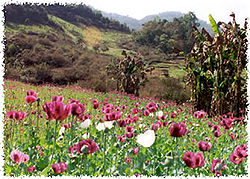
An opium poppy field in full bloom along the Angara River Valley. Opium is the main cash crop for many Fellaheen farmers.
Even before the Calzadorian Empire first sent soldiers into what is presently known as Asir, the province played a large part in the illegal drug production in the Mainland, especially opium production, but also other various illicit drug crops as well. Opium itself can be used for pharmaceutical means, such as the creation of morphine and codeine and other important medicines. Unfortuanetly, much of the opium poppy harvest goes to illicit means, namely the creation of heroin. This has made the opium the most lucrative crop for the Fellaheen. The cultivation is so widespread and such an integral part of their livelihood that Pontic authorities have found it almost impossible to find a solution for eradicating the crop from Bedouin society. Because of the vast wealth accumulated from the illicit drug trade, drug cartels have established their presence in Karachi and entrenched themselves in Asir's society as a whole. Pontic law enforcement tends to not interfere in cartel business as long as the groups forgo violence and blatant drug running, preferring to keep it hidden from the public's eye as long as law and order are respected.
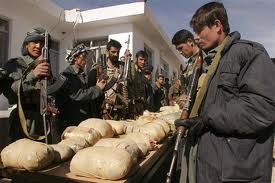
Wahabbi rebels surveying a shipment of opium on its way out of Asir to be refined into heroin.
Another negative side effect from the drug trade is that the Wahabbis have put the drug smuggling routes firmly under their control, taxing the produce as it passes out of the province overland into other lands of the Greater UKO and the world at large. This has allowed the normally destitute Wahabbi tribemen to arm themselves with all sorts of modern weaponry to fight the Pontic military.

An Imperial Farming Permit. This license allows certain Fellaheen farmers to grow opium for strictly legitimate trade in the medicinal and pharmaceutical fields.
As of January 1, 2977, Emperor Attalus I signed into law a licensing and documentation program. The aim of this was to allow farmers register with the Pontic government and allow their opium harvests to be sold for legitimate production of medicines, pharmaceutical needs, and food ingredients. The program will try to reduce the illegal drug trade that overshadows all other forms of legitimate agriculture in Asir and allow the government to track the source of the opium from fields to hospitals or clinics.
Throughout the years of 2979-2980, General Samaras ordered several large scale drug raids by Pontic security units, which apprehended almost a hundred cartel members and roughly 13 tons of processed heroin. This resulted in a lowering of cartel activity due to the crackdown. These raids were the result of several violent public displays in the countryside by the cartels as they feuded and competed with each other over territory and smuggling routes. These were the largest recorded drug seizures in the UKO's history to date. After the raids, cartel activity lowered markedly and they largely disappeared from public but no doubt still exist and are active in the drug trade. After the 2990 surrender of almost all Bedouin tribes, illicit opium production has plummeted, but no doubt the drug trade and cartels have managed to survive.
Asir and the Greater UKO Community[]
After internal security was largely secured, the Pontic Empire has integrated with the rest of the South Centura Donna Peninsula via trade and expanded infrastructure. The highly lucrative Asiri economy, especially the city of Karachi itself, bloomed further yet from this globalization and fiscal expansion.
The province's economy was disturbed considerably in 3002-3 by a short colonial war between Pontus itself and Persia, the owner of the neighboring country of the Kingdom of West Bavaria. After several border clashes involving Wahabbi tribes residing in West Bavaria extreme western fringes, IAFA forces entered Persian territory and engaged in full scale warfare once it was discovered that the Bedouin bandits were armed with modern Persian armaments.
Expansion of the Province[]
By late 3003, the war was over and had resulted in a complete Pontic military victory. General Markos Samaras as Field Commander of the IAFA and Imperial Administrator of Asir, ordered the administrative and territorial consolidation of the former territory of West Bavaria into an enlarged province of Asir. The capital of West Bavaria, Caspian Sea, was renamed Peshawar. All other towns and major settlements had been destroyed during the conflict and would only be rebuilt under Pontic supervision and discretion. Pontic settlers and slave labor flocked to Peshawar as they discovered enormous deposits of various metals, and minerals. Mines quickly sprung up, the population of the city swelled from a post war level of 10,000 to almost 45,000 residents.

The Persian settlement of Rize in the summer of 3005. This hamlet is the only Persian village in the eastern region and handles most of the local population's commerce during this season.
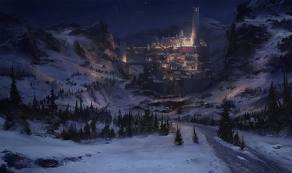
Rize during the winter of 3005-6. The eastern region is largely untravelled in the winter months due to mountain passes and roads being snowbound and the cold weather discouraging almost all travel except along the Trans-Asiri Railroad.
The Trans-Asiri Railroad has been expanded through the Pontic Mountains in the center of the province to the east to link up with the rest of the Greater UKO's rail network through the Persian region. The expansion was considered extremely ambitious and nearly impossible due to the treacherous terrain that had to be constructed over. The Anatolian Mountains, which covered all of the Persian lands in the eastern region, were far higher than the Pontic Mountains in the central region. At nearly 25,000 feet in elevation, these were literally the most difficult tracks ever laid thus far in the history of the UKO countries. Nearly 3,000 laborers died or were maimed by accidents during construction or the extreme weather conditions that were endured whilst the construction was underway. In the year 3008, the final tracks were laid in the extreme east of the province, where the Anatolian Mountains give way to the flat plains of the Ardglass Colony. With this, the province of Asir was finally linked by land with the rest of the UKO countries, provinces, and regions.

The city of Peshawar, a city centered on the mining industry in the eastern region of Asir.
Energy Exploration & Relations with the Kingdom of Aryana[]
After the great infrastructure upgrading program that saw Asir modernize, the provincial administration was changed. The Imperial Administrator, General Markos Samaras, had presided over Asir governance for 41 years. His advanced age and faltering health from over four decades of service to the Empire had taxed him greatly, and Emperor Zeno decided to replace him upon the General reaching the military's mandatory retirement age of 70 years.
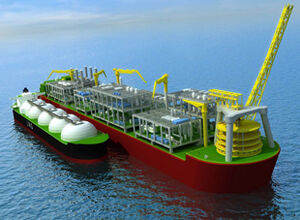
A Pontic mining ship that acts as a floating drilling platform and refining facility for both offshore oil and natural gas production.
On March 15, 3015, Samaras was retired from public duty, and his successor was announced. Colonel Sixtus D'Alessio was chosen to succeed him in the capacity of Imperial Administrator. He was considered a good choice and very popular with Asir's residents and general populace since he was the son of a Pontic immigrant to Asir. At 39 years of age, he was considered a rising star in the PAF, and a youthful military commander who was more at ease in administration and politics than some of his other contemporaries.
His first acts were immensely popular with all and the Emperor hoped that this would endear the new Imperial Administrator to the various Asiri peoples. Zeno had placed much faith in this young commander, who had proven himself by displaying his loyalty to the dynasty during the attempted coup d'etat after the Galatian Withdrawal.
The first act was to abolish all income taxes, due to the lucrative export trade that Asir had with the rest of the UKO community. Fiscally, the province had achieved independence from the Empire as a whole and was working on economic self sufficiency by exploiting mining and agricultural exports that were in high demand throughout the world. It was believed that the provine could achieve most of this goal within 30 years of steady development, and an economic program was established to attain this.

Colonel Sixtus D'Alessio, the 2nd Imperial Administrator of Asir, stand at the center of a meeting of local Pontic commanders .
Another act was to open up much of the Lockenhess Sea to energy exploration. Enviromental concerns have always been a serious consideration within Pontic society, as was demonstrated by General Samaras not allowing exploration in the Sea until corporations could demonstrate that they could access and retrieve undersea raw materials without any environmental impact whatsoever. These methods and techniques had been perfected by the time Colonel D'Alessio came to power, and he immediately gave the three largest energy corporations within the Empire permission to begin. Only three months into the exploration period mining ships were already making inroads to tapping into an immense reserve of both oil and natural gas whose exact size and composition couldn't readily be calculated.
These energy exploration did come at a cost however. After the Pontic-Persian Colonial War, a newly formed realm known as the Kingdom of Aryana had risen out of the northernmost fringes of West Bavaria's former territory and further north yet amidst unorganized lands along the Lockenhess Sea. Diplomatic flurries began when D'Alessio proclaimed Pontic suzerainty over the whole eastern Lockenhess Sea coastline. The Aryana aristocracy refused to acknowledge this and tension began to rise along the border. In response to this, D'Alessio ordered the Pontic Navy to begin patrolling the coastline and guarding the mining ship convoys that were in the Sea.
The Third Great War[]
Year of Trench Warfare[]
The year of 3017 saw an initial tactical withdrawal from the northeastern edge of the Asiri frontier. Colonel D'Alessio ordered his mobilized forces to withdraw inward to a prepared series of elaborate trench lines stretching from the Lockenhess Sea to the Hope Gulf. Once the Aryanan forces reached this prepared position, they were forced to halt after several failed attempts to breach the Asiri lines. After this, Norte soldiers came to assist the IAFA in the form of three divisions of shock troops to help secure the front lines.
Hope Gulf Pocket[]
As 3017 came to a close, the Supreme Command of the PAF (Pontic Armed Forces) was making dilligent plans for the southeasternly portion of their front. It was here that the most southernly Aryanan troops were stationed, disproportionately almost half their forces, with the other half in the north along the Lockenhess Sea and Calzadorian troops in between. Due to a combined effort with Norte troops after three months' logistical planning. On June 1st, 3018 Pontic forces began a saturation bombardment that lasted three days. In the aftermath, both nations' troops broke through above the southern mass of Aryanan troops and circled behind them. This operation was completed within 5 days and encircled almost 100,000 Aryanan troops which comprised half of the Kingdom of Aryana's mobilized manpower. After several attempts to arrange a surrender failed the Pontic Air Force carpet bombed the newly dubbed "Hope Gulf Pocket", resulting in the complete destruction of the enemy's trapped military forces. The total human cost from this was 90,000 Aryanan troops killed and the rest wounded or surrendering to Asiri forces. Asiri and Norte forces combined lost just short of 20,000 men in this operation.
Static Defense, Realignment, and Operation Ptah[]
The rest of 3018 involved IAFA forces realigning correctly to switch most of their manpower heavily to face what remained of Aryana's fighting forces. The IAFA commanders also correctly deduced that their Calzadorian counterparts were only interested in making half hearted, sporadic forays against Asiri lines. Pontic spy planes had informed the UKO nations at this time that the Calzadorians were placing most of their forces into their fronts against their Norte foes in Comancheria/Yugobania and Lusitanian forces in the Ardglass Colony.
The beginning of 3019 saw all Norte forces in Asir being airlifted back home to their respective provinces because of several Calzadorian offensives in those regions. With this, a top secret maneuver was underway to almost completely strip their eastern front facing the Calzadorians of men and shifting them to the Lockenhess Sea coastline in preparation for a new, decisive offensive. Calzadorian intelligence never noticed this, which would prove to be an immense tactical error to their overall strategic position in the west.
On May 13, 3019 Operation Ptah began. It involved three Asiri Field Armies to strike the remaining Aryanans and force the Calzadorian armies to retreat to the north in conjunction with an ongoing series of Lusitanian attacks intended on liberating the Ardglass Colony. Another massive aerial and artillery bombardment resulted in a complete demoralization of the Aryanan defenders, and after 48 hours a uncontested advance began. The IAFA forces pounced quickly, forcing the Aryanans to retreat rapidly and taking immense casualties in the meantime. While this was all going on, the Calzadorian armies in the south were forced to withdraw in the face of Asiri and Lusitanian assaults back across the borders into the interior of the Kingdom of Aryana.
The northern push along the coastline was very successful, with the IAFA forces only halting when their supplies ran out. By this time they had taken almost 75,000 prisoners and killed around 12,000 men of which almost all were Aryanan soldiers. With this swift operation, all of Asir was once again under Pontic control and IAFA forces were just inside the southwestern frontiers of Aryana and the Kingdom's military capacity to resist armed forces had dwindled to almost nothing at all. Even token resistance couldn't be found as Asiri forces gradually geared up for a march north again, only to stop when facing Calzadorian troops who were now in charge politically and militarily in Aryana.
Final Operations and Aftermath[]
With the Calzadorian military broken and in full retreat from Lusitanian and Norte armies across the front, Asiri forces went on a final push to clear all of Aryana of enemy combatants. In November 3020, Asiri forces entered central Aryana and faced token resistance. Most Calzadorian forces withdrew in the face of the new Asiri attacks, retreating northwards towards the unorganized territories between the Calzadorian Empire and Aryana. After this, in January 3022 the Treaty of Thrassen was announced between Lusitanian representatives and Calzadorian plenipotentiaries. This virtually ended the war itself, however it technically left the Norte, East Heaven, and Asiri allies still in a state of war with the Empire.
Treaty of Lockenhess[]
On February 16, 3022 onboard a Pontic warship off the far northeastern coastal tip of the Lockenhess Sea, Colonel D'Alessio signed a peace treaty with an ambassador from the Calzadorian Empire. The terms were rather much in the Asiris, with the Empire agreeing to pay $100 million Asiri dinars worth of reparations and renouncing all claims to the lands around the Lockenhess Sea. The Calzadorians also recognized Asir's addition of the Aryanan coastline to Asir proper. With this the Kingdom of Aryana was proclaimed a province of the Pontic Empire, renamed Jizan. By 3025, all of the financial and economic effects of the war had been eased. As the province's finances improved, and with Calzadorian war reparations, the physcial damage done to the countryside was completely restored to its prewar condition with the help of Lusitanian engineers and advisors. With this, the greatest threat that Asir had yet known had passed into history.

